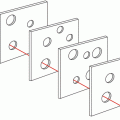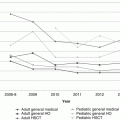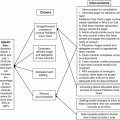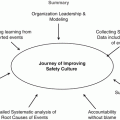Source and domain/setting
Definition
Characterized as
benefits
persistence/continuation
development
Merriam-Webster [20] (English dictionary)
• “able to be used without being completely used up or destroyed”
• “able to last or continue for a long time”
X
Rogers (2003) [21] (sociology; diffusion of innovations)
• “the degree to which an innovation continues to be used after initial efforts to secure adoption is completed” (p. 429)
• “the degree to which a programme of change is continued after the initial resources provided by a change agency are ended” (p. 376)
X
Bowman et al. (2008) [22] (health care)
• “the continued use of core elements of an intervention and persistent gains in performance as a result of those interventions” (p. 11)
X
X
• “the programme components developed and implemented in earlier stages are (or are not) maintained after the initial fundings or other impetus is removed” (p. 322)
• “the continued use of programme components and activities (beyond their initial funding period) for the continued achievement of desirable programme and population outcomes” (p.2060)
X
X
Stetler et al. [24](nursing)
• “changes (practice and outcomes) … that continue over time as related to specific projects” (p.19)
X
X
Davies and Edwards (2013) [25] (health care)
• “the continued implementation of innovations over time and depends on the ability of workers, organizations and healthcare delivery systems to adapt to change” (p. 237)
X
?
Mancini and Marek (2004) [26] (health promotion)
• “the capacity of programmes to continuously respond to community issues” (p. 339)
X
?
X
Gruen et al. (2008)[27] (public/community health; health care)
• “complex systems that encompass programmes, health problems targeted by programmes and programmes’ drivers or key stakeholders, all which interact dynamically in any given context” (p. 1579)
• “capability of being maintained at a certain rate or level” (p. 1580)
?
X
?
• “the process through which new working methods, performance goals and improvement trajectories are maintained for a period appropriate to a given context” (p. 189; p. xxii)
X
X
X
Johnson et al. (2004) [28] (health promotion)
• “the process of ensuring an adaptive prevention system and a sustainable innovation that can be integrated into ongoing operations to benefit diverse stakeholders” (p.137)
X
X
X
Bevan et al. (2002) [29] (health care)
• “when new ways of working and Improved outcomes become the norm … the process and outcome [are] changed … the thinking and attitudes behind them are fundamentally altered … the systems surrounding them are transformed in support… it has [withstood] challenge and variation … evolved alongside other changes in the context and perhaps has actually to improve over time” (p. 12)
X
X
X
According to Greenhalgh et al. [8], spread, diffusion, and dissemination are similar terms that are often used interchangeably, when, in fact, they have subtle but important distinctions between them. Spread (e.g., within an organization) involves the exchange of knowledge and experience via clear communication and education on specific work practices, maximizing process improvements, and the development of interventions. In contrast, diffusion refers to the unplanned, informal, and decentralized process of spread. Dissemination is the spread of innovation that is planned, formal, and centralized, but occurs through vertical hierarchies. Greenhalgh et al. [11] summarize these definitions of spread (as seen in Table 7.2). Two additional terms are equally notable: (1) assimilation, which describes more complex adoption processes, including formal decision making, an evaluation phase (or phases), and planned sustained efforts at implementation; and (2) implementation, which encompasses the active and planned efforts to mainstream an innovation within an organization [12].
Table 7.2
Definitions of spread
Source | Definition | Comments |
|---|---|---|
Damanpour and Gopalakrishnan (1998) [30] | “… an organization’s means to adapt to the environment, or to pre-empt a change in the environment, in order to increase or sustain its effectiveness or competitiveness. Managers may emphasize the rate or speed of adoption, or both, to close an actual or perceived performance gap” | Adoption of innovations |
Rogers ([13], p. 5) | Diffusion is the process by which an innovation is communicated through certain channels over time among the members of a social system | Diffusion refers to spread of abstract ideas and concepts, technical information, and actual practices within a social system, from a source to an adopter, typically via influence or communication |
Wejnert (2002, [31] p. 297) | “… identifying the factors that influence the spread of innovations across groups, communities, societies, and countries … an area of inquiry referred to formally, as diffusion” | |
Mowatt and colleagues (1998, [32] p. 669) | Dissemination is actively spreading a message to defined target groups. | |
The Modernisation Agency (NHS Modernisation Agency, 2003 [33]) | Spread is the extent to which learning and change principles have been adopted in other parts of the organization that could benefit from them. This includes not only those parts of the organization that are the same as the original improvement site but also spread to other parts of the service that have similar processes or face similar issues. Spread means that the learning which takes place in any part of an organization is actively shared and acted upon by all parts of the organization. Improvement knowledge generated anywhere in the healthcare system becomes common knowledge and practice across the healthcare system. | Berwick prefers the term “re-invention” to spread |
Inherent to any discussion of sustainability and spread is the concept of innovation. Ideally, it is an innovation which improves care that we hope is sustained and spread throughout the clinical setting. It should be noted that not all innovations are improvements. Rogers [13] defines an innovation as, “an idea, practice, or object that is perceived as new by an individual or other unit of adoption.” Four core characteristics of innovation, as identified by Osbourne [14], are particularly relevant to the healthcare setting:
- 1.
Innovation represents newness (but not necessarily improvements).
- 2.
It is not the same thing as invention (the latter is concerned with the discovery of new ideas or approaches whereas innovation is concerned with their application).
- 3.
It is both a process AND an outcome.
- 4.
It involves discontinuous change (as opposed to incremental development of practice).
Fraser et al. [15] and Osbourne [14] also classify innovations into four categories with application to the healthcare setting, namely:
- 1.
Developmental innovations (existing services to a particular user group are improved or enhanced);
- 2.
Expansionary innovations (existing services are offered to new user groups);
- 3.
Evolutionary innovations (new services are provided to existing users); and
- 4.
Total innovations (new services to new users).
Understanding the nuances between each of these categories is essential to the improvement leader, whose knowledge of the innovation to be “hardwired,” and then spread to other colleagues or units throughout the healthcare organization is ideally conducted from a position of expertise. Having one’s conceptual frameworks clearly in mind and recognizing the multi-variate factors at play in a complex, unpredictable environment can help facilitate change, even anticipate barriers or resistance should they arise. Finally, Buchanan, Fitzgerald, and Ketley [3] from the UK expand upon this discussion, by taking a more ecological or systems-based approach, describing different levels at which change may occur, which can be simplified for the purposes of our discussion as, change and adoption of innovation occurring at the (1) individual, (2) unit, and (3) across organizational levels.
Models/Frameworks
With the definitions provided above, Fleiszer et al. [2] frame sustainability as a multi-dimensional, multi-factorial concept that may ideally be viewed as having three characteristics and four pre-conditions; all drawn from their comprehensive concept analysis (Fig. 7.1). These three characteristics include: (1) benefit, (2) routinization/institutionalization, and (3) development. Briefly, the benefit characteristic of sustainability relates to the idea that only effective and valuable innovations should be sustained. There are two perspectives when considering the benefit characteristic, namely (1) objective (quantifiable results that formally confirm the achievement of an outcome), and (2) subjective (perceived value that is more informal in nature that confirms the positive results to involved stakeholders).


Fig. 7.1
Concept analysis for the sustainability of healthcare innovations. Fleiszer et al. [2]. Used with permission
The routinization/institutionalization characteristic of sustainability refers to the adoption of practices that indicate that the innovation has moved from “new” to “accepted,” and its structures and processes are now woven into the fabric of a specified setting. In the clinical setting, this embedding process would be referred to as being accepted as a “standard of care” or as a “best practice.”
Development, as a characteristic of sustainability, describes the sense of ownership by key stakeholders, who: (1) invest in the ongoing study and enhancement of the initial innovation, but (2) address the need to apply the innovation in continually evolving environments. This requires constant renewal, re-invention, and resilience. The ability to adjust and refine an innovation allows stakeholders to recognize that the ideas and improvements are ultimately their own. The recognition that development can occur reinforces the sense of ownership and desire to invest and re-invest in maintaining (or sustaining) the change process.
In addition to characteristics essential to sustaining an innovation, Fleiszer et al. [2] articulate several pre-conditions that influence sustainability. These four pre-conditions include: (1) innovation, (2) context, (3) leadership, and (4) processes. Briefly, the innovation pre-condition relates to aspects of the innovation itself. This can best be summarized as, the “fit” with the mission, and its relevance towards addressing the need (or solving the problem). The pre-condition related to context addresses both internal and external aspects of a given setting. Internal context involves organizational culture and project management capacity to keep an innovation on track. External context relates to policy, regulations, legislation, and financial pressures (i.e., funding or market-place associated). The leadership pre-condition addresses the prowess of the improvement champions and management team to generate support and inspire engagement. Finally, the process pre-condition resembles quality improvement paradigms, such as performance monitoring and the ability to plan, trial, and implement.
Scherier [5] conducted a review of the empirical literature around program sustainability, and graphically represents the chronology of sustaining an innovation in Fig. 7.2. He suggests that the change process begins with the introduction of the innovation into the setting (initiation), and then progresses through implementation, and finally, adoption within the setting. Over time, the innovation is either fully or partially implemented, as determined by an evaluation of the effort. The innovation is then seen to either be sustained, abandoned, or replaced.
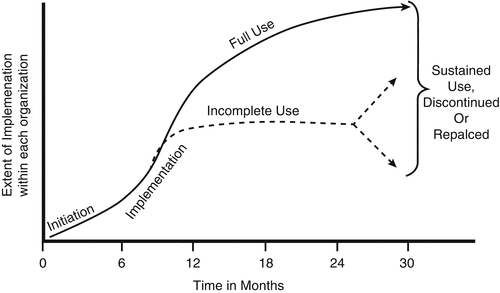

Fig. 7.2
Implementation of an innovation and possibility of sustained use. Scheirer [5]. Used with permission
Both Scheirer [5] and Fleiszer et al. [2] agree that sustainability hinges on: (1) perceived benefits by stakeholders involved in the innovation, (2) the existence of effective processes to implement and ultimately routinize (institutionalize) the change going from new to expected practice, and (3) the existence of some level of flexibility, such that unique contextual aspects can be recognized and accommodated. Both authors also recognize the need for leadership in the form of a “champion” for a given innovation, as well as the need for the innovation to fit within the mission of the key stakeholders.
In addition, Scheirer [5] specifically draws attention to the observation that innovations may be either fully or partially implemented over time. A number of factors affect the extent to which an innovation is fully implemented. She specifically advocates for the use of established evaluation methods and tools (e.g., logic models, key driver diagrams), to assist in defining the components that are essential in achieving the desired outcome. Linking her work on sustainability to the field of implementation science, Scheirer [5] addresses the concept of spread (or specifically, dissemination) as an important dimension after an innovation is sustained in its original setting.
Spread, essentially the adoption of an innovation beyond its original implementation site, may occur in a variety of ways. Buchanan et al. [3] offer the idea of spread as occurring across a continuum (Fig. 7.3): moving from copying the innovation exactly as it was previously implemented to the other extreme, where the original innovation serves only as a guiding framework for action in the new setting.


